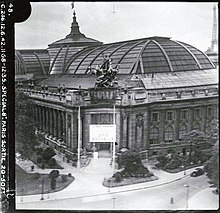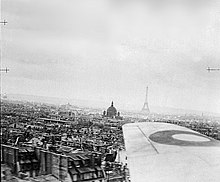Operation Squabble


Operation Squabble ( Operation Squabble ) was a British propaganda campaign over Paris, which was occupied during World War II . On June 12, 1942, a single plane dropped French flags and symbolically attacked the German occupation forces.
preparation
The plan for this operation goes back to September 1941, when Major Ben Cowburn jumped undercover from the Special Operations Executive over France and learned in Paris of a regular military parade on the Avenue des Champs Élysées . In his opinion, attacking this parade should boost French morale. Back in London , Cowburn proposed his idea to the Royal Air Force . The plan was supported by Philip Joubert de la Ferté , the commander of the RAF Coastal Command , which had French ancestors.
The first plan was to send three Supermarine Spitfires equipped with long-range tanks to Paris. There they were supposed to create a blue-white-red tricolor in the sky by means of smoke generators . But then it was decided to use a single Bristol Beaufighter that was supposed to drop a French flag. In addition, the Hôtel de la Marine , where the Navy had its headquarters , was added as a second destination.
A volunteer request has been made to the Coastal Command squadrons . Because of the secrecy, the mission profile was only vague. All the squadrons had sent at least one suggestion. On April 30, the decision fell on the crew Lieutenant Alfred Kitchener Gatward ( pilot ) and Sergeant George Fern ( navigator ) of the 236th Squadron. It was not until May 5th that Gatward and Fern found out more about the planned action. They began their training on RAF Thorney Island . They practiced on-board weapon attacks on shipwrecks in the English Channel and studied the city map of Paris and the appearance of prominent buildings.
A large French flag provided should be hand-launched via the flare-drop facility. However, the flag turned out to be too big. It was therefore divided in half, so that there were now two flags. The parachute department prepared the two flags with iron pipes as a weight. Gatward and Fern also trained how to drop the flags and how to fold them before dropping them.
The first attempt to reach Paris was made on May 13; this had to be canceled due to bad weather over France. Three more attempts were made but each was interrupted due to weather conditions.
attack
The next attempt was made on June 12; Gatward and Fern took off from Thorney Island around eleven thirty in light rain. When they reached the French coast at Fécamp about half an hour later , the weather conditions improved so that they set course for Paris. At low altitude they flew only 10 to 30 m above the ground. From Rouen they followed the Seine . Bird strikes in the radiator increased the oil temperature; because the plane was close to its destination, Gatward decided to continue the flight.
At 12:27 pm they passed the Eiffel Tower in an arc. Gatward climbed almost 100 m to start the attack on the parade over the Champs Élysées. Fern dropped a flag over the triumphal arch . But there was no sign of a parade on the Champs Élysées. An anti-aircraft gun opened fire, but missed the aircraft. Gatward and Fern chased low over the Champs Élysées. At the Place de la Concorde Gatward made a 270 ° turn and then attacked the naval headquarters with on-board weapons. Fern dropped the second flag over the building. At 12:30 pm Gatward steered the way back. Another anti-aircraft gun fired without hitting the aircraft.
On the return flight, they were not threatened by interceptors or air defense. But the long low flight led to a strong insect impact on the windshield, which increasingly deteriorated visibility. A short rain shower over the English Channel washed away the insects. At 1:53 pm Gatward and Fern landed at RAF Northolt . During the flight, Fern took about 60 pictures with the heavy F24 camera .
reception
Two days after the action, the Parisians were informed about the action through dropped leaflets . On June 17, the French international program of the reported BBC in broadcasting it. The American Life magazine published a report including Fern's recordings in August 1942.
Operation Squabble did not cause direct military damage to the enemy, but it was very successful propaganda. It strengthened the morale of the occupied French and their resistance movement; it humiliated the enemy and demonstrated the capabilities of the Royal Air Force. It was also important to the morale of the British because the Axis powers were still on the rise; on July 20, Rommel conquered Tobruk, North Africa , in the Theseus company .
For this campaign Gatward was awarded the Distinguished Flying Cross and Fern was awarded the Distinguished Flying Medal . After the war, in July 1949, Gatward and Fern were publicly honored in London by representatives of the French embassy.
There is no satisfactory explanation as to why Gatward and Fern did not encounter the military parade. One of the possible explanations is that the German occupiers adjusted the time zone in France to that in Germany, causing the parade to be postponed.
Web links
Individual evidence
- ↑ a b c d e f g Martin Bowman: Battlefield Bombers , Verlag Pen and Sword, 2014, ISBN 9781783831975 pp. 150–152 [1]
- ↑ David Buttery: Napoleon's Paris: A Guide to the Napoleonic sites of the Consulate and First French Empire 1799-1815, published by Pen and Sword Military, 2020, ISBN 9781526749505 pp 92-93 [2]
- ↑ a b c d e f g Andrew D. Bird: Heroes of Coastal Command: The RAF's Maritime War 1939-1945 , Verlag Pen and Sword, 2019, ISBN 9781526710710 "Chapter 9" [3]
- ↑ a b c d Roy Conyers Nesbit: The Strike Wings: Special Anti-Shipping Squadrons 1942-45 Verlag Casemate Publishers, 2014, ISBN 9781783378609 "Chapter 9" [4]
- ^ British take a Look at Paris in: Life , August 10, 1942
- ↑ The Royal Air Forces Association: It was crammed with Huns, and we had something for them ... , June 12, 2020
- ↑ Beau Flies the Flag at: aeg.org.uk


